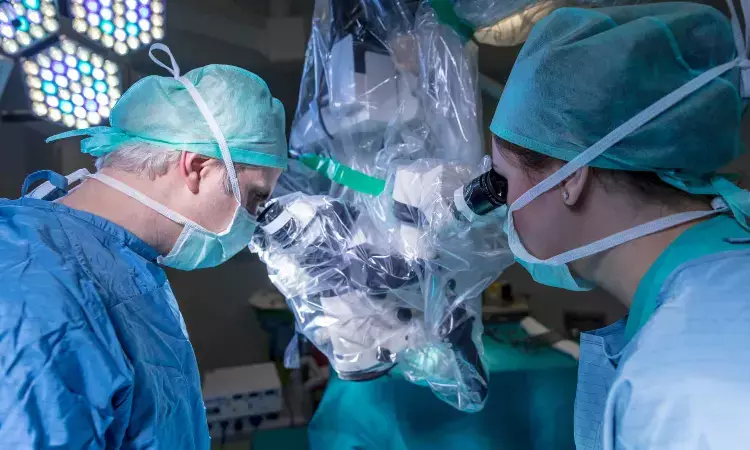- Home
- Medical news & Guidelines
- Anesthesiology
- Cardiology and CTVS
- Critical Care
- Dentistry
- Dermatology
- Diabetes and Endocrinology
- ENT
- Gastroenterology
- Medicine
- Nephrology
- Neurology
- Obstretics-Gynaecology
- Oncology
- Ophthalmology
- Orthopaedics
- Pediatrics-Neonatology
- Psychiatry
- Pulmonology
- Radiology
- Surgery
- Urology
- Laboratory Medicine
- Diet
- Nursing
- Paramedical
- Physiotherapy
- Health news
- Fact Check
- Bone Health Fact Check
- Brain Health Fact Check
- Cancer Related Fact Check
- Child Care Fact Check
- Dental and oral health fact check
- Diabetes and metabolic health fact check
- Diet and Nutrition Fact Check
- Eye and ENT Care Fact Check
- Fitness fact check
- Gut health fact check
- Heart health fact check
- Kidney health fact check
- Medical education fact check
- Men's health fact check
- Respiratory fact check
- Skin and hair care fact check
- Vaccine and Immunization fact check
- Women's health fact check
- AYUSH
- State News
- Andaman and Nicobar Islands
- Andhra Pradesh
- Arunachal Pradesh
- Assam
- Bihar
- Chandigarh
- Chattisgarh
- Dadra and Nagar Haveli
- Daman and Diu
- Delhi
- Goa
- Gujarat
- Haryana
- Himachal Pradesh
- Jammu & Kashmir
- Jharkhand
- Karnataka
- Kerala
- Ladakh
- Lakshadweep
- Madhya Pradesh
- Maharashtra
- Manipur
- Meghalaya
- Mizoram
- Nagaland
- Odisha
- Puducherry
- Punjab
- Rajasthan
- Sikkim
- Tamil Nadu
- Telangana
- Tripura
- Uttar Pradesh
- Uttrakhand
- West Bengal
- Medical Education
- Industry
Preserving subacromial bursa in rotator cuff repair may improve patient outcomes, finds study

Over 500,000 surgeries are performed every year in the US to repair rotator cuff injuries, but a significant number of these procedures do not achieve the desired outcomes. A recent research published in the Science Translational Medicine journal suggests that a reevaluation of surgical practices like the routine removal of the subacromial bursa may be required.
The subacromial bursa is a synovial-like tissue located between the rotator cuff and the acromion. Traditionally, it has been removed during rotator cuff surgeries due to its perceived role in contributing to shoulder pathologies. However, this study utilized proteomic profiling of bursa samples from patients with rotator cuff injuries provides compelling evidence that the bursa actually plays a beneficial role in the healing process.
The study analyzed the response of bursa to tendon injuries in both human patients and a rat model and found that the bursa not only helped to maintain the mechanical properties of the intact infraspinatus tendon which lies next to the injured supraspinatus tendon, but also protected the underlying humeral head by preserving bone morphometry. This protective mechanism suggests that the bursa has a more complex and constructive role than previously understood.
Further experiments in the rat model revealed that the bursa stimulated an inflammatory response that is pivotal for wound healing in the injured tendon. This was marked by the initiation of genes associated with healing processes like the Cox2 and Il6. The positive influence of the bursa was also observed in rat bursa organ cultures by reinforcing the findings from live animal models.
This study involved the use of polymer microspheres loaded with dexamethasone which were delivered to intact bursae of rats after a tendon injury. The release of dexamethasone from the microspheres effectively reduced the expression of inflammatory markers like Il1b in the injured tendon. This research highlights the potential of the subacromial bursa as a novel target for drug delivery systems to enhance the healing process by modulating inflammation directly at the injury site. Overall, the study suggest that preserving the subacromial bursa during rotator cuff repairs could improve patient outcomes by utilizing the natural protective and healing properties of bursa.
Reference:
Marshall, B. P., Ashinsky, B. G., Ferrer, X. E., Kunes, J. A., Innis, A. C., Luzzi, A. J., Forrester, L. A., Burt, K. G., Lee, A. J., Song, L., Lisiewski, L. E., Soni, R. K., Hung, C. T., Levine, W. N., Kovacevic, D., & Thomopoulos, S. (2024). The subacromial bursa modulates tendon healing after rotator cuff injury in rats. In Science Translational Medicine (Vol. 16, Issue 744). American Association for the Advancement of Science (AAAS). https://doi.org/10.1126/scitranslmed.add8273
Neuroscience Masters graduate
Jacinthlyn Sylvia, a Neuroscience Master's graduate from Chennai has worked extensively in deciphering the neurobiology of cognition and motor control in aging. She also has spread-out exposure to Neurosurgery from her Bachelor’s. She is currently involved in active Neuro-Oncology research. She is an upcoming neuroscientist with a fiery passion for writing. Her news cover at Medical Dialogues feature recent discoveries and updates from the healthcare and biomedical research fields. She can be reached at editorial@medicaldialogues.in
Dr Kamal Kant Kohli-MBBS, DTCD- a chest specialist with more than 30 years of practice and a flair for writing clinical articles, Dr Kamal Kant Kohli joined Medical Dialogues as a Chief Editor of Medical News. Besides writing articles, as an editor, he proofreads and verifies all the medical content published on Medical Dialogues including those coming from journals, studies,medical conferences,guidelines etc. Email: drkohli@medicaldialogues.in. Contact no. 011-43720751


